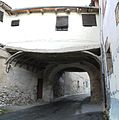Fuentidueña
| Fuentidueña municipality | ||
|---|---|---|
 Fuentidueña - the townscape
|
||
| coat of arms | Map of Spain | |
 Help on coat of arms |
|
|
| Basic data | ||
| Autonomous Community : |
|
|
| Province : | Segovia | |
| Comarca : | Comunidad de villa y tierra de Fuentidueña | |
| Coordinates | 41 ° 27 ′ N , 3 ° 59 ′ W | |
| Height : | 870 msnm | |
| Area : | 50.55 km² | |
| Residents : | 147 (Jan. 1, 2019) | |
| Population density : | 2.91 inhabitants / km² | |
| Postal code : | 40357 | |
| Municipality number ( INE ): | 40092 | |
| administration | ||
| Website : | Fuentidueña | |
Fuentidueña is a place and a municipality ( municipio ) with 147 inhabitants (as of January 1, 2019) in the central Spanish province of Segovia in the autonomous community of Castile and León . Due to the large number of historical buildings, the place was classified as a cultural asset ( Bien de Interés Cultural ) in the category Conjunto histórico-artístico in 1997 .
Location and climate
The place Fuentidueña is located on a mountain slope at an altitude of about 860 to 890 m on the Río Duratón about 33 km (driving distance) northwest of the small town of Sepúlveda . The distance to the provincial capital Segovia is about 73 km to the south. The climate is temperate to warm; Rain (approx. 460 mm / year) falls throughout the year, with the exception of the dry summer months.
Population development
| year | 1857 | 1900 | 1950 | 2000 | 2017 |
| Residents | 327 | 453 | 562 | 181 | 141 |
As a result of the increasing mechanization of agriculture , the abandonment of many small farms and the resulting loss of jobs in the countryside, the place has lost a lot of inhabitants since the middle of the 20th century.
economy
The place lives mainly from agriculture (agriculture) and tourism (rental of holiday apartments).
history
The place was not insignificant in the Middle Ages - an inscription carved in a stone commemorates a battle against the army of Almansor in 1002 immediately before their defeat at Calatañazor . Possibly a castle (castillo) was already standing at this time , which was later expanded under Alfonso VIII and his successors and occupies a whole hilltop. The high Middle Ages are considered to be the heyday of the place - several Romanesque churches were built during this time.
Attractions
- The townscape is characterized by partially built-over alleys with balcony porches resting on supports (soportales) .
- The old parish church (Iglesia de Santa María) in the center of the village is originally a late Romanesque building from the 13th century, but it was changed at a later date and is no longer used today because of its ruinous condition. You can see the Romanesque apse , two portals and some remains of the capital washed out by rain and wind .
- A medieval bridge, which was repeatedly restored in later times, spans the Río Duratón.
- The half above-ground storage cellars ( bodegas ) made of large and small stones are also worth seeing . The rear part is driven into the soil interspersed with field stones , which means that a constant temperature of around 10 ° C to 15 ° C is achieved in summer and winter.
- Above the village stands the Romanesque church of San Miguel , which now serves as the parish church, with its originally preserved apse with figural capitals and consoles and a restored south porch with double and quadruple columns ( portico or galería porticada) .
- New York, USA
- The well-preserved apse of St. Martin (San Martín) of a nearby Cistercian monastery , which was abandoned in the 17th or 18th century, was sold to the USA in 1957 - despite its classification as a national cultural asset ( Bien de Interés Cultural ) - and is now in Museum The Cloisters in New York , where the completely renovated church interior is used for services and concerts. Only the ruins of the outer walls of the nave, made of quarry stones (mampostería), and the remains of an excavated medieval cemetery (necrópolis) exist on the spot .
Bridge over the Río Duratón
Stone cellar ( bodegas )
Web links
- Fuentidueña, Miscellaneous - Photo + info (Spanish)
- Romanesque churches in Fuentidueña and surroundings - photos + information (Spanish)
Individual evidence
- ↑ Cifras oficiales de población resultantes de la revisión del Padrón municipal a 1 de enero . Population statistics from the Instituto Nacional de Estadística (population update).
- ↑ Fuentidueña - climate tables
- ↑ Fuentidueña - population development
- ^ Fuentidueña / New York - Apse of the Church of San Martín






